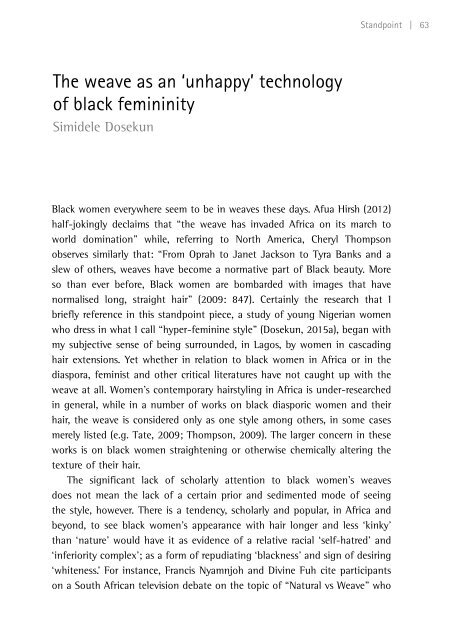The politics of fashion and beauty in Africa
fa21_proof_3
fa21_proof_3
You also want an ePaper? Increase the reach of your titles
YUMPU automatically turns print PDFs into web optimized ePapers that Google loves.
St<strong>and</strong>po<strong>in</strong>t | 63<br />
<strong>The</strong> weave as an ‘unhappy’ technology<br />
<strong>of</strong> black fem<strong>in</strong><strong>in</strong>ity<br />
Simidele Dosekun<br />
Black women everywhere seem to be <strong>in</strong> weaves these days. Afua Hirsh (2012)<br />
half-jok<strong>in</strong>gly declaims that “the weave has <strong>in</strong>vaded <strong>Africa</strong> on its march to<br />
world dom<strong>in</strong>ation” while, referr<strong>in</strong>g to North America, Cheryl Thompson<br />
observes similarly that: “From Oprah to Janet Jackson to Tyra Banks <strong>and</strong> a<br />
slew <strong>of</strong> others, weaves have become a normative part <strong>of</strong> Black <strong>beauty</strong>. More<br />
so than ever before, Black women are bombarded with images that have<br />
normalised long, straight hair” (2009: 847). Certa<strong>in</strong>ly the research that I<br />
briefly reference <strong>in</strong> this st<strong>and</strong>po<strong>in</strong>t piece, a study <strong>of</strong> young Nigerian women<br />
who dress <strong>in</strong> what I call “hyper-fem<strong>in</strong><strong>in</strong>e style” (Dosekun, 2015a), began with<br />
my subjective sense <strong>of</strong> be<strong>in</strong>g surrounded, <strong>in</strong> Lagos, by women <strong>in</strong> cascad<strong>in</strong>g<br />
hair extensions. Yet whether <strong>in</strong> relation to black women <strong>in</strong> <strong>Africa</strong> or <strong>in</strong> the<br />
diaspora, fem<strong>in</strong>ist <strong>and</strong> other critical literatures have not caught up with the<br />
weave at all. Women’s contemporary hairstyl<strong>in</strong>g <strong>in</strong> <strong>Africa</strong> is under-researched<br />
<strong>in</strong> general, while <strong>in</strong> a number <strong>of</strong> works on black diasporic women <strong>and</strong> their<br />
hair, the weave is considered only as one style among others, <strong>in</strong> some cases<br />
merely listed (e.g. Tate, 2009; Thompson, 2009). <strong>The</strong> larger concern <strong>in</strong> these<br />
works is on black women straighten<strong>in</strong>g or otherwise chemically alter<strong>in</strong>g the<br />
texture <strong>of</strong> their hair.<br />
<strong>The</strong> significant lack <strong>of</strong> scholarly attention to black women’s weaves<br />
does not mean the lack <strong>of</strong> a certa<strong>in</strong> prior <strong>and</strong> sedimented mode <strong>of</strong> see<strong>in</strong>g<br />
the style, however. <strong>The</strong>re is a tendency, scholarly <strong>and</strong> popular, <strong>in</strong> <strong>Africa</strong> <strong>and</strong><br />
beyond, to see black women’s appearance with hair longer <strong>and</strong> less ‘k<strong>in</strong>ky’<br />
than ‘nature’ would have it as evidence <strong>of</strong> a relative racial ‘self-hatred’ <strong>and</strong><br />
‘<strong>in</strong>feriority complex’; as a form <strong>of</strong> repudiat<strong>in</strong>g ‘blackness’ <strong>and</strong> sign <strong>of</strong> desir<strong>in</strong>g<br />
‘whiteness.’ For <strong>in</strong>stance, Francis Nyamnjoh <strong>and</strong> Div<strong>in</strong>e Fuh cite participants<br />
on a South <strong>Africa</strong>n television debate on the topic <strong>of</strong> “Natural vs Weave” who



